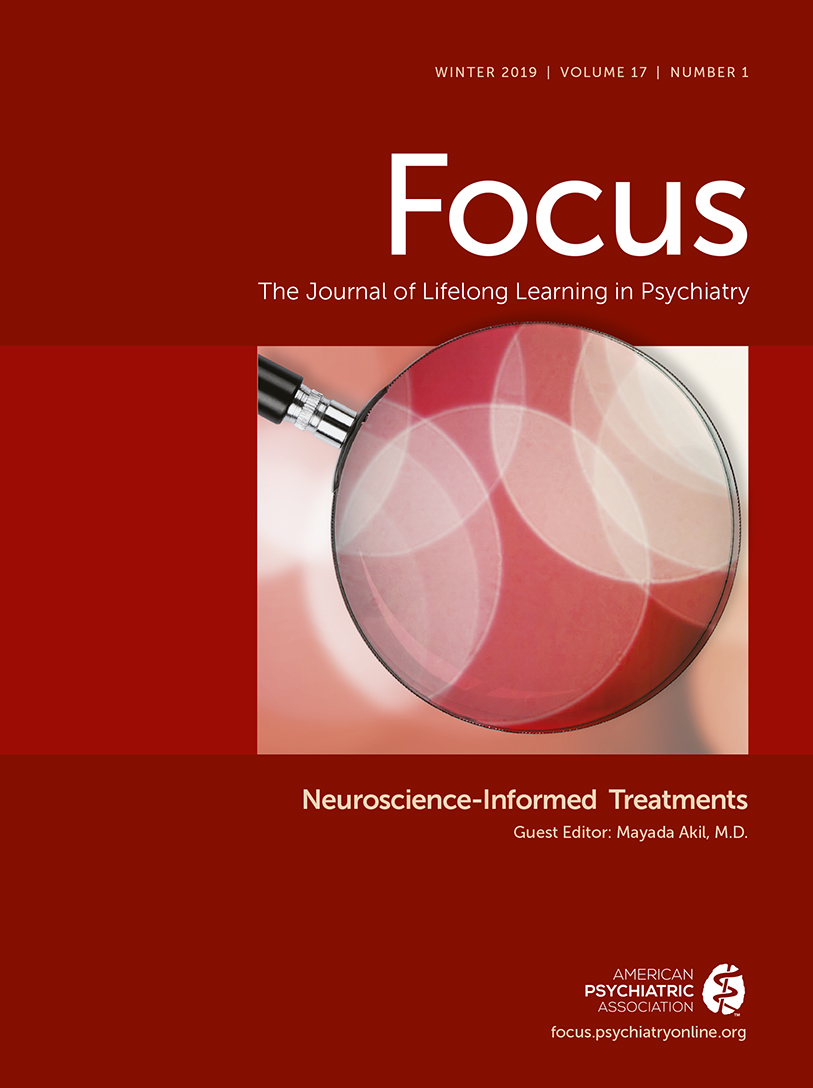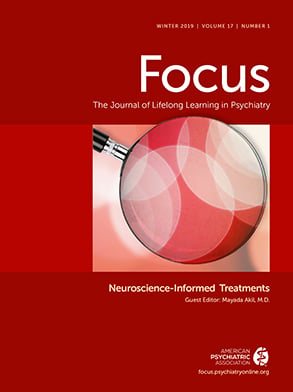Popular media is saturated with stories about psychiatry and psychiatric illness. Depending on the source, these articles may help educate our patients and the public about psychiatric disorders and provide health-promoting advice, or they may provide misleading information and reinforce stigma toward our field and toward the patients we treat (
1). Patients should be encouraged to seek information from professionals about the mental health and treatment information that they may have accessed on popular media. This is an opportunity for open dialogue about a patient’s hopes and fears about diagnoses and treatment. It is also an opportunity to use the literature to practice critical appraisal skills and to assist in skill building so that patients can become more informed media consumers. This information may help patients to avoid being seduced into trying unproven remedies and “cure-alls.”
One resource to assist psychiatrists in talking to patients about the neurobiological underpinnings of common psychiatric disorders is the National Neuroscience Curriculum Initiative (NNCI) (
1). The mission of the NNCI is “to create, pilot, and disseminate a comprehensive set of shared resources that will help train psychiatrists to integrate a modern neuroscience perspective into every facet of their clinical work.” This online resource teaches residents and more senior psychiatrists about the neuroscience underpinnings of the field—including encouraging lifelong learning through the appraisal of relevant scientific literature and cutting-edge neuroscience findings. One of the modules includes assisting physicians to critique media coverage of issues relevant to psychiatry and to demonstrate the ability to communicate thoughtfully with patients and a lay audience (
2). This article models this method through a vignette and discussion of a highly relevant topic in psychiatry and the media: Internet gaming disorder (IGD) and Internet addiction.
Clinical Vignette
Tony Jones is a 16-year-old adolescent who is in the 10th grade at his local public school. Over the past year, his grades have been declining, and his mother, Ms. Jones, reports that he is not sleeping well, has lost motivation for his school work, and has missed school because of staying up most of the night playing his new multiplayer video game. His mother noted that he started the game over the summer, when it did not interfere with other activities, but that now he seems to be quite “obsessed” with the game. His parents have made rules about how much he can play the game, and it is located in the den of the home, a public space, so that his use may be monitored. Since school started, he has continued to play the game as soon as he gets home. When he needs to do homework, he often rushes through it so that he can play again. His mother has discovered that he pretends to go to sleep at the expected time at night but sneaks down to the den when the rest of the household is asleep to play the video game for many more hours during the night.
Ms. Jones has received psychiatric treatment for many years for a chronic anxiety disorder. Mr. Jones is recovering from substance and alcohol abuse. Having recently read an article in the
National Post on Internet addiction with the headline, “My Son Was Addicted to the Internet: A Mother’s Story of the Battle to Save Her Teenager’s Life From Online Gaming” (
3), Mr. and Ms. Jones are particularly concerned about Tony. They had initially been relieved that he was not “partying” with friends—using alcohol and drugs, as Tony’s father had done in high school. Now, they are concerned that Tony may be addicted to the Internet. The
National Post article suggested that the teenager’s “recovery all came down to him making the decision to get better.” Was there really nothing that Tony’s parents could do? They are consulting Dr. Nolan, a child and adolescent psychiatrist, about what they read in the
National Post to determine whether Tony has an Internet addiction; whether it has changed his brain; and what, if anything, they can do about it.
Critique of Media Coverage
Psychiatrists require skills to read and appraise the scientific literature. However, few get training or consider the skill of interpreting lay media stories about psychiatric disorders and how to help patients appraise this literature. Lay media stories may include well-researched articles in reputable newspapers, magazines, or websites. It may also include information designed to sell clinically questionable products and those without data supporting their use. Differentiating the quality of various media sites may be difficult. Those with simple explanations and easy answers may be compelling but misleading. Physicians should be prepared with a method of assessing the lay media and interpreting it for patients.
In the previous vignette, Dr. Nolan reviewed the article that the family brought from the
National Post. Dr. Nolan had a basic knowledge of Internet gaming disorder and let the family know that it was not yet an accepted diagnosis but a “condition for further study” in the
DSM-5 (
4). In addition, Dr. Nolan provided a quick PubMed literature search for Mr. and Ms. Jones, including diagnostic criteria for Internet gaming disorder and epidemiological data that ranged in prevalence from 1% to 36.7% (
5). Internet users have been reported to use online gaming compulsively, to the exclusion of other interests, and to experience significant impairment and distress as a result. It is this functional impairment that leads to Internet use becoming a disorder. The disorder is most common among young males in Asia but becoming more pervasive around the globe. Dr. Nolan discussed the hypothesis that reward processing centers were very likely involved—much like with other addictions or gambling disorders. Mr. and Ms. Jones wanted to know if the gaming is changing Tony’s brain. How can they stop him or motivate him to want to stop playing on the Internet for multiple hours per day?
Dr. Nolan decided that an effective method of discussing the functional impairment as well as potential treatment modalities would be to draw the purported circuitry of Internet gaming disorder for the family. The NIDA website
www.drugabuse.gov (
6) displayed a brain image depicting the reward circuitry. Dr. Nolan chose this to help the family understand the brain areas involved and which interventions might be helpful in relation to these neuropathways.
Dr. Nolan pointed and drew arrows as she described the brain activity to Mr. and Ms. Jones: “The ventral tegmental area (VTA) and nucleus accumbens (NA) are the brain regions associated with reward seeking. Using a car analogy, these regions ‘turn on the gas’ and motivate pleasure seeking. In this case, the gas is dopamine, the brain chemical that spikes when associated with a pleasurable activity. From there, the neural connections go to the orbitofrontal cortex. This might be thought of as the steering wheel, and it directs the neuronal impulses to the prefrontal cortex (PFC)—the brake. The PFC allows the person to consider consequences of actions and delay immediate gratification. It reminds the person that doing homework and studying are important. The neuronal loop comes back to the amygdala and hippocampus. There, the experience is processed into short-term memory and is associated with emotion. The person remembers the pleasure associated with gaming (
7).
“In the case of Internet gaming disorder, we think that the circuit gets ‘hijacked,’ so that it mostly bypasses the prefrontal cortex brakes. Thus, it is harder to stop playing an addictive game. The spikes of dopamine bring pleasure, so the person needs to keep playing the game to avoid the dopamine ‘crash’ associated with stopping.”
Mr. and Ms. Jones asked about the article: “Is it true that they need to wait for Tony to decide that he wants help for his addiction?” “Well, yes and no,” Dr. Nolan answered. “It is true that trying to force a teen into treatment often is not very effective. However, knowing what we know about brain chemistry can help us target treatments. And, we haven’t heard from Tony what his aspirations and interests are, in addition to gaming. This is essential.”
Dr. Nolan then reviewed the brain circuitry to note that treatment can occur at various points in the reward circuit (
7–
12). For example, minimizing game playing or playing less intense games can decrease the dopamine spike in the VTA and NA. Therapy can improve the functioning of the PFC and problem-solving skills. Cognitive-behavioral therapy, motivational interviewing, or family therapy may help. If attention-deficit hyperactivity disorder (ADHD) symptoms have been impairing, then ADHD medications can increase the cognitive control as well. Finding alternative pleasurable activities, such as sports, may be very helpful. These activities provide an alternative method of increasing dopamine that allows the activity to be pleasurable but has added benefits of exercise and socialization.
The following are tips to enhance a critical review of a media topic with a patient (
2):
1.
What is the central claim or “take-home point” of the media piece?
A.
Is the “take-home point” one that psychiatric expertise would endorse?
B.
What is the neuroscientific evidence about the take-home point?
2.
What is the author’s agenda? Is there bias? What is the “hook” to get people to care about it?
A.
Is the media piece well informed and balanced?
B.
Does the piece overstate its claims to make the point?
3.
What is the face validity of the media piece’s central claim?
A.
Do the claims resonate with what you know about psychiatry?
4.
What questions does your patient have?
A.
Inquire about your patient’s hopes or concerns about what they have read.
B.
Is the article proposing a new treatment or alternative treatments that have little evidence to support them?
C.
Listen carefully and discuss openly what you know and don’t know about the topic in the media article.
D.
Try looking up answers together during the session. This allows modeling of how to find evidence-based information on the topic.
E.
Embrace complexity—there is rarely a simple answer. This is because brains (and people) are amazingly complex. Your wonder and awe of neuroscience will be contagious.
5.
Did the literature search help answer the questions? What follow-up may be needed?
A.
Cultivate an attitude of curiosity. Encourage open discussion about psychiatric disorders, treatments, and the evidence base.
B.
Be transparent about the medical field being in constant development. There is ambiguity in all of medicine (not just psychiatry).
C.
Wonder aloud about the patient’s interest in a particular media article. Does it suggest a point of view or skepticism that they share? Listen carefully to motivations as a guide to what is most important to the patient.

